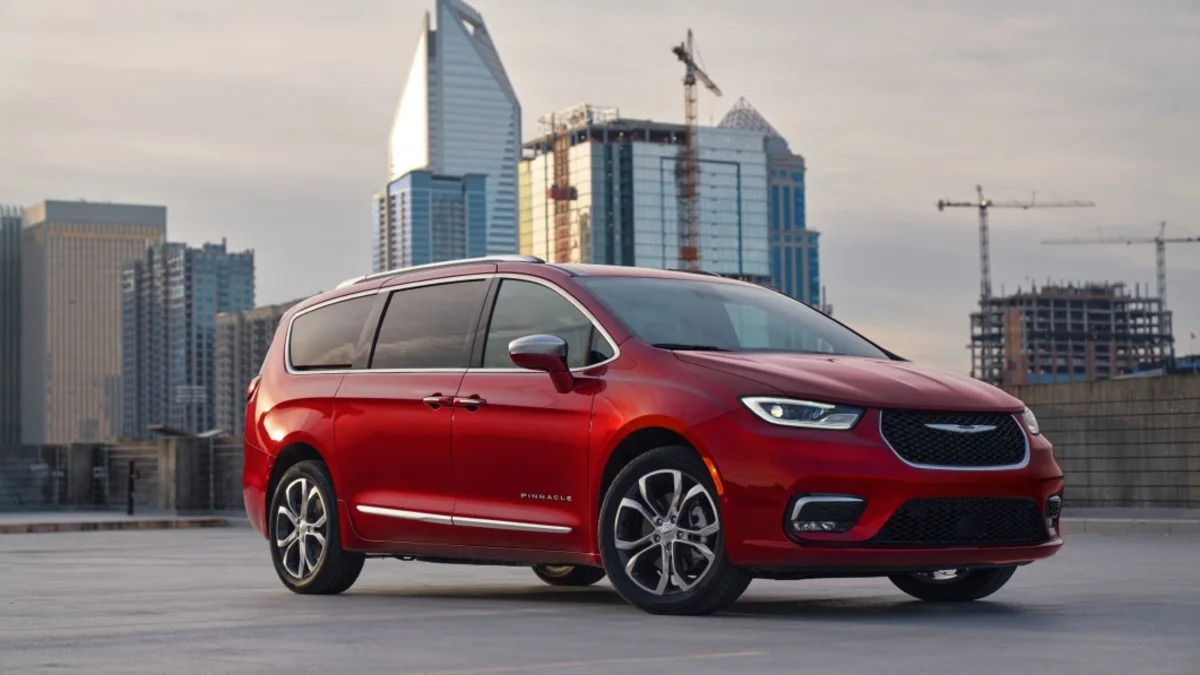While its nameplate is relatively new, the Chrysler Pacifica traces its roots to the model that defined the minivan as we know it today: the Plymouth Voyager. Chrysler is celebrating 40 years of building family haulers by making a handful of small updates to the Pacifica for 2024.
Don't expect to find a "40 Years Edition" trim the next time you visit a Chrysler dealer. Changes for the 2024 model year are largely limited to new paint and interior colors. Red Hot and Baltic Gray join the palette, and buyers who order the range-topping Pacifica Pinnacle model can select a new interior color called Sepia. Chrysler has also pared down the Plug-In Hybrid range to two models called Select and Pinnacle, respectively. Customers can add the optional S Appearance, Premium S Appearance, and Road Tripper packages to the base Select trim.
The final update for 2024 is minor but important. The Uconnect 5 infotainment system gains an Emergency Vehicle Alert System (EVAS) that warns the driver if it detects an active fire truck, an active ambulance, or "other nearby roadway hazards," according to Chrysler.
Chrysler dealers across the nation will begin receiving the 2024 Pacifica in the coming weeks.
Moving your family and your stuff for 40 years
Plymouth, which Chrysler closed in 2001, built the first Voyager at the Windsor plant in Canada on November 2, 1983. The van went on sale as a 1984 model and became what most historians consider the first modern minivan. The idea of designing a box on wheels tailor-made for families wasn't new: the 1930s Stout Scarab, the original Volkswagen Bus released in 1950, the Fiat 600 Multipla launched in 1956, and the Renault Espace unveiled shortly after the Voyager filled the same void, but it's the Chrysler Corporation's definition of a minivan that stuck.
The original Voyager was also sold as the Dodge Caravan (1984) and the Chrysler Town & Country (1990). The three models leveraged a unique set of attributes to stand out from other vans on the market, including car-derived underpinnings (many existing models were related to bulky commercial vehicles), front-wheel-drive, and a sliding door that made the cabin easy to get in and out of. Stow 'N Go seats didn't appear until the 2004 model year, but Chrysler's early vans featured removable rear seats for weekend trips to the hardware store.
SUVs and crossovers often get blamed for killing the station wagon, but the minivan arguably started the war. Chrysler's rivals quickly took notice: Chevrolet and GMC launched the Astro and the Safari, respectively, for 1985 and Ford released the Aerostar in 1986. Japanese companies took much longer to fire back: Toyota's funky Previa landed for 1990 with a mid-mounted engine and the Honda Odyssey arrived for 1994, though sliding rear doors didn't appear until the North America-built second-generation model went on sale for 1999.
Plymouth charged $8,280 for a base 1984 Voyager, which is about $24,500 in 2023. Power came from a carbureted, 2.0-liter four-cylinder engine that sent 90 horsepower to the front wheels via a five-speed manual transmission. For context, the 2024 Pacifica costs $40,020 including a $1,595 destination charge, and its 3.6-liter V6 sends 287 horsepower to the front wheels via a nine-speed automatic gearbox.
Related Video


Sign in to post
Please sign in to leave a comment.
Continue